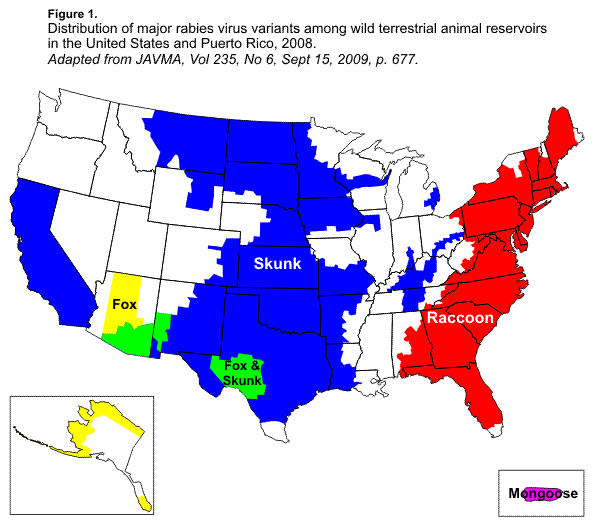Rabies in Wildlife
 Rabies is one of the most common disease that is associated with wild animals, rabies in a disease that effects the central nervous system..
Rabies is one of the most common disease that is associated with wild animals, rabies in a disease that effects the central nervous system..
Rabies is a disease that is preventable in mammals and is most often transmitted through the bite of an animal such as a Fox, Raccoon, Skunk or Bat. it is possible to be transmitted through domestic animals also. Animals such as dogs and cats can transmit the disease to humans.
The most common rabies carriers
The most common carrier of rabies in the United States is bats, Rabies in bats is estimated to effect 1/2 of one percent of all bats in the United States, this number is from the US Center for Disease Control, the most common way a bat will transmit the rabies disease to a human is through a bite. This bite is often unnoticed, because the bat has very fine, very sharp teeth. A human can very rarely even feel a bat bite. The most common scenario is when a human is sleeping, a bat fly's in the room and land on the bed or area where the person is sleeping. The person then rolls over on the bat, the bat bites as a defensive reaction.
Other Rabies Carriers
The other types of mammals that are known to carry and transmit the rabies virus in order from the CDC is the following; also, the map above is is from the University of Kentucky and it outlines the most common rabies vector in a particular area of the United states.
1)Raccoon:
2)Skunks:
3)Fox:
These are the most "common" animals that are known to carry the disease. However all types of mammals are thought to be carriers of this viral disease. Other not so common carriers of this disease are: Groundhogs, Beavers, Rabbits, Goats and even Cows...YES, Cows have been documented to carry rabies.
Symptoms of Rabies in mammals
Some of the signs and symptoms that a warm blooded animal has the rabies virus are the following most common signs.
1) Aggressive Behavior
2) Drooling
3) Lack of Appetite
4) Excessive Sleeping
If you feel you have encountered a animal with rabies, we advise you to contact your local animal control office, this number can be found in the blue pages of your local phone book, or you can find the number by googling the county website in which you live in.
If you are having problems with a wild animal and want it removed, you can refer to our wildlife experts list found here We also have a page that is dedicated to most all types of disease found in wildlife.
